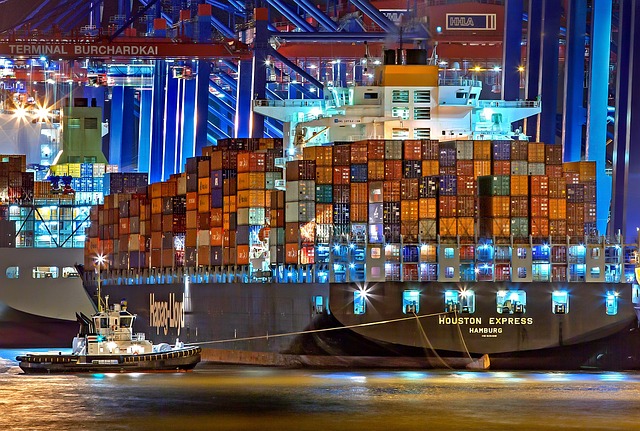
-
The global maritime trade is expected to grow 2.4% in 2023 despite a 0.4% contraction in volumes in 2022, according to the UNCTAD Review of Maritime Transport 2023
-
Through 2028, maritime trade volumes are projected to advance above 2%
-
Containerized trade, which sank by 3.7% in 2022, is forecast to expand by 1.2% in 2023 and more than 3% between 2024 and 2028
-
The maritime sector faces the daunting challenge of decarbonization while navigating economic and geopolitical headwinds
-
UNCTAD is pushing for a green transformation in the sector, with cleaner fuels and digital innovations crucial to combating carbon emissions and regulatory uncertainty
-
The industry’s greenhouse gas emissions, which account for 3% of the global total, have increased by 20% over the last decade
-
Without action, emissions could reach 130% of their 2008 levels by 2050
-
Transitioning to cleaner fuels comes at a price costing $8 billion to $28 billion annually to decarbonize ships by 2050
-
To develop infrastructure for 100% carbon-neutral fuels by 2050, even larger investments of $28 billion to $90 billion annually are needed
The maritime trade is expected to grow 2.4% in 2023 despite a 0.4% contraction in volumes in 2022, according to the United Nations Conference on Trade and Development (UNCTAD) Review of Maritime Transport 2023.
Through 2028, maritime trade volumes are forecast to advance above 2%.
The UNCTAD report, released ahead of World Maritime Day on September 28, noted “the maritime industry showed remarkable resilience, adapting to new, lengthier trade routes” amid a “turbulent global landscape marked by geopolitical events like the war in Ukraine.”
Containerized trade, which dropped by 3.7% in 2022, is projected to expand by 1.2% in 2023 and more than 3% between 2024 and 2028. Trade volumes remain, however, below pre-COVID-19 levels.
In the energy sector, the oil and gas trades surged 6% and 4.6% respectively in 2022 as pandemic restrictions eased, according to the UNCTAD report.
Tanker and dry bulk rates, key industry barometers, have also shown positive trends. Tanker freight rates, crucial for oil and gas transport, peaked in 2022 and remain strong in 2023. But uncertainties due to the energy transition and new regulatory requirements could limit future carrying capacity.
Dry bulk rates, affecting commodities like grain and coal, were volatile in 2022 due to shifting demand, port congestion, geopolitical tensions, and weather disruptions, peaking in May before falling to pre-pandemic levels by the year’s end. Rates have since rebounded as demand surged and China’s industries recovered.
Challenge of decarbonisation
Meanwhile, the maritime sector faces the daunting challenge of decarbonization while navigating economic and geopolitical headwinds, UNCTAD said.
UNCTAD Secretary-General Rebeca Grynspan highlighted the urgency, saying, “Maritime transport needs to decarbonize quickly while ensuring economic growth. Balancing environmental sustainability, regulatory compliance, and economic demands is vital for a prosperous, equitable, and resilient future for maritime transport.”
The industry’s greenhouse gas emissions, which account for 3% of the global total, have increased by 20% over the last decade. Without action, emissions could reach 130% of their 2008 levels by 2050, UNCTAD said.
Complicating matters is an ageing world fleet. As of early 2023, the average ship’s age was 22.2 years. With over half now older than 15 years, many ships are either too old to retrofit or too young to scrap.
Digitalization was also highlighted as a way to speed up decarbonization efforts, improving efficiency and reducing delays.
Shamika N. Sirimanne, UNCTAD’s director of technology and logistics, said using AI, machine learning, blockchain, and IoT can make ships run better. These technologies monitor ships, find the best routes, control speed, and predict maintenance needs. This helps cut emissions, save money, and make shipping greener.
Heavy cost of greening the industry
The urgency of decarbonization is evident, yet the sector faces multibillion-dollar investments amid uncertainty about the best transition methods.
Alternative fuels show promise, but their adoption remains in the early stages, with 98.8% of the fleet still sailing on fossil fuels. The silver lining is that 21% of vessels on order will operate on cleaner alternatives like liquefied natural gas, methanol and hybrid technologies.
Transitioning to cleaner fuels comes at a price. UNCTAD reported it will cost $8 billion to $28 billion annually to decarbonize ships by 2050.
To develop infrastructure for 100% carbon-neutral fuels by 2050, even larger investments of $28 billion to $90 billion annually are needed.
These costs could increase annual fuel expenses by 70% to 100%, potentially impacting small island developing states and least developed countries that heavily rely on maritime transport.
To ensure fairness, UNCTAD called for a universal regulatory framework that applies to all ships, regardless of their origin, ownership, or area of operation.
Sirimanne suggested economic incentives such as levies on shipping emissions to promote the use of alternative fuels and support digital connectivity in ports.
Another layer of complexity is the question of who is responsible for the transition. The major flag states Liberia, Panama, and the Marshall Islands, which account for a third of shipping’s carbon emissions, will be responsible for enforcing new green shipping standards. But the onus for funding the energy shift falls on ship owners.
Navigating this complex tangle of economic, regulatory and environmental priorities is the industry’s next big test. Decisions on decarbonization measures are taken by the International Maritime Organization and its members.
RELATED READ: UNCTAD sees slower growth of 1.4% in global maritime trade for 2022




